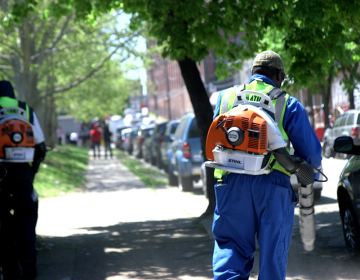Updated: Strange streets of blue glazed brick and wooden block
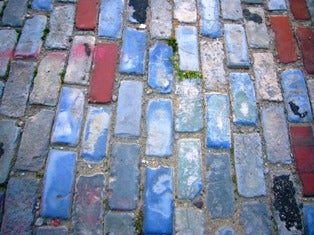
Just before Waverly Street dead-ends into South Carlisle Street, a block from Broad and Lombard, the pavement gets your attention, changing from monochromatic asphalt to several hues of bright blue brick.
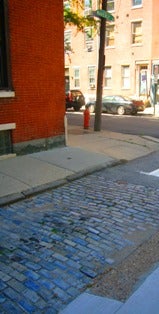
Actually, the blue bricks are mixed in with red, gray and white pavers, a pattern that had colonial roots. In the Annals of Philadelphia in the Olden Time, John Watson describes the brick work around Anthony’s House on Chestnut Street.
“The bricks too, all now painted red, were originally regularly intermixed with the blue glazed bricks – a token, only belonging to the grades of best houses.”
There is precious little published about the blue glazing of streets here, aside from Nathaniel Popkin’s Phillyskyline mention of similar paving on the 1400 block of Addison (mere blocks from the Waverly spot) and a few alleyways between Third and Fifth in Northern Liberties.
Planphilly scribe Matt Blanchard put me onto the blue bricks. Contact me at mgolas@design.upenn.edu if you know anything about this construction or are aware of other spots in the city where it occurs.
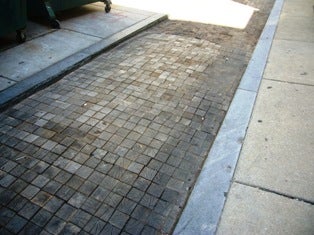
A more obvious but no less interesting surface is the neat collection of wood squares that make up several blocks on Camac Street between 12th and 13th and Walnut and Locust in Center City.
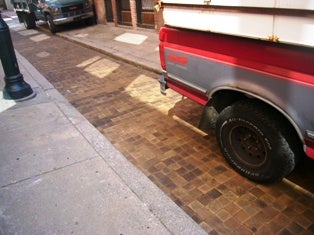
Purported to be the last wooden street in America, Camac has been undergoing patchwork renovation this summer, which appears to be complete. None of the blocks are original, but the re-creation is authentic.
This just in:
Here’s a treasure trove of Camac Street info sent to us by Harry Kyriakodis, the Librarian for the American Law Institute/American Bar Association and an avid amateur historian.
Camac Street: The Little Street of Clubs
The stretch of Camac Street between Walnut and Locust Streets is home to the clubhouses of several longstanding artistic and literary organizations, all mostly Bohemian/artistic in nature. Reflecting Philadelphia’s reputation for its lack of avantgarde expression, the two-story 19th century houses were once collectively referred to as “Egg Head Row.” More recently, the narrow thoroughfare has been called the “Greenwich Village” of Philadelphia, given the number of artists and writers who reside in the area and frequent the clubs, studios and taverns. Camac Street—once called the “biggest little street in the world”—was officially named “Avenue of the Artists” by the City of Philadelphia in 2001.
The block of South Camac Street between Walnut and Locust Streets is lined with small blocks of wood, a common type of pavement in the early 1800s. As such, this is supposedly the only wooden block street in America. It was originally covered this way for the sake of the inns and clubs along the narrow road, as horse hooves make less noise on wood than on cobblestones. The lane’s wooden blocks need a high degree of maintenance and were last replaced in the late 1990s. Years before, the Philadelphia Department of Streets wanted to replace them with more durable materials, but local residents persuaded the city to keep this one block in historical condition.
Just wide enough for one vehicle, Camac Street was originally named after Captain Turner Camocks (1751-1830), a wealthy Irish copper mine owner who was related to the Penn family through marriage. He had emigrated to Philadelphia in 1804.
——————-
Among those who cherish the quaintness which most American cities lack, Camac Street is widely known. Here in a narrow side street, just off the broad thoroughfares where the traffic roars, is a quiet cluster of some of the most attractive small club houses in America.
Philadelphia has its great social and business organizations, with quarters equal in grandeur and comfort to those of other cities, but it is most proud, perhaps, of its little clubs of artists, writers, and similar groups of the people who conspire to make life in Philadelphia interesting and inspiring, as well as industrious.
The very names of these clubs are suggestive of their charm—Le Coin D’Or, The Stragglers, The Sketch Club, The Plastic Club, The Poor Richard Club, The Franklin Inn, The Meridian Club, the Princeton Club. The visitor to Philadelphia who is so fortunate as to be invited into any of these characteristic gathering places will find the interiors as well worth while as the picturesque exteriors.
–From Philadelphia: Historical, Central, Metropolitan, Industrial (Philadelphia, PA: Public Ledger Co., 1922), at 66.
++++++++++++++++++++++++++
The Philadelphia Sketch Club is the oldest art club in the United States run by the artists themselves. On November 20, 1860, six “Bohemian” students from the Pennsylvania Academy of Fine Arts, met at 125 South 11th Street to form a “sketching club.” They sought illustration and design opportunities not available at the Academy.
The Sketch Club responded to the educational needs of the arts community in the early 1870s when the Pennsylvania Academy of the Fine Arts was awaiting completion of its new building and was without instructional facilities. Under the auspices of the Club, life drawing classes were conducted with Thomas Eakins as instructor. Lectures on anatomy were also delivered. When the Academy opened its new building in 1876, Eakins, an honorary member of the Club, volunteered to take over its life classes, undoubtedly utilizing his teaching experiences gained at the Sketch Club. By 1894, the Sketch Club had 400 active members, including many instructors at the Academy. As the years passed, the roll call of distinguished artists, past and present, continued to grow.
Almost from its start, the Sketch Club has had a history of successful exhibitions, beginning with its first Small Oils Show, a competition which has been held every year since 1865. Small Oils medalists themselves constitute a minor overview of who’s who in Philadelphia painting. Since that first show, the Club’s exhibitions have grown to embrace all the visual arts, including prints, sculpture, and photography.
The present clubhouse, at 235 S. Camac Street, was converted from three separate buildings built between 1822 and 1828. Its main areas are a large, skylighted gallery which stretches across the entire top floor, and meeting and activity rooms at street level, complete with manteled fireplaces. The upper walls of the library hold 44 portraits of early members painted by Thomas Anshutz while he was Dean of the Pennsylvania Academy of the Fine Arts. The library opens onto a terraced garden and fish pond. Scattered throughout the club are wooden ship models, stained glass windows, pottery, antique iron work, and art objects made or donated over the last 100 years or more. The gallery is the focal point for all exhibitions, lectures, and studio workshops.
–From www.sketchclub.org/docs/history.html (January 2002).
——————-
The Sketch Club, oldest art club in the United States, is at 233-35-37. This club played a major part in the rejuvenation of the street, for when it moved its headquarters there in 1902, other art and business groups followed. Outgrowth of the proposal of George F. Bensell, illustrator for a society of artists, the club held its first meeting at the Academy of the Fine Arts in 1860. A charter was secured in 1889, and for a few years the group met in a building on the present site of Broad Street Station. The Sketch Club gained prominence during the World War by selling $3,700,000 worth of Liberty Bonds. Many noted American artists of the last 50 years have been members, among them Joeeph Pennell, Thomas Anshutz, Nicola D’Ascenzo, R. Blossom Farley, Nathaniel Little, Weyman Adams, and Richard Bishop. The club has a magnificent library of art works, including many cartoons. A rathskeller, richly furnished with hand-carved chairs, and chess and billiard rooms are maintained for the relaxation of the members. The public may view the art works only during the club’s free exhibitions, held at various times during the year.
–From Works Project Admin., WPA Guide to Philadelphia: A Guide to the Nation’s Birthplace (Philadelphia, PA: William Penn Assn. of Philadelphia, Inc., 1937), at 425-426.
——————-
The Philadelphia Sketch Club: This club of artists, organized in 1861, is believed to be the oldest of the art clubs of America. Many of those who have been, or continue to be, active in its affairs have become noted as painters, sculptors and illustrators. The quaint club house, located in Camac Street, south of Locust Street, is a centre of real Bohemia. The club maintains a cafe, excellent library of art books and a spacious exhibition gallery.
–From Frank H. Taylor, comp., Poor Richard’s Dictionary of Philadelphia (Philadelphia, PA: J.B. Lippincott Co., 1916), at 129.
++++++++++++++++++++++++++
The Philobiblon Club is Philadelphia’s club for book collectors (whether personal or institutional), booksellers and anyone interested in books. Apparently the fourth such bibliophile organization in the nation, it was founded in 1893 after a small group of book collectors received notice of the club’s founding and were asked to subscribe ten dollars to the cause.
In 1922, Dr. A.S.W. Rosenbach became president of the Philobiblon Club, a post he would hold for the next thirty years. Under the Doctor, many of the most famous names in the book world were asked, cajoled, even bullied into speaking to the Club. The Doctor’s feat is all the more remarkable considering that the Club paid no honoraria to these famous speakers.
Today, the Philobiblon Club meets regularly at The Franklin Inn Club on Camac Street. The membership has reflected the changes in the book community of Philadelphia and is largely made up of librarians and booksellers with a smattering of collectors. The Club is affiliated with the Fellowship of American Bibliophilic Societies.
–Adapted from http://philobiblonclub.org (July 2006).
++++++++++++++++++++++++++
Located at 247 Camac Street, The Plastic Club of Philadelphia is America’s oldest art club for women. Founded in 1897, it was created with the intention for an organization of women artists to have their turn since men already had several art organizations. From this point on it was decided that the time was ripe to start an organization of this caliber. The Plastic Club was founded by those represented in all of the art schools in the city including the Academy of Fine Arts, the School of Design for Women (now the Moore Institute), and Howard Pyle’s Wilmington School. The group met in the studio of John F. Boyle, a famous Philadelphia sculptor. This club combined social and art interests with a membership limited to “women engaged in the pursuit of art in any of its branches.” Lectures were given by prominent artists and directors of art education.
———————
Since 1897, The Plastic Club has been devoted to the promotion and preservation of the visual (plastic) arts in Philadelphia. The busy gallery schedule offers several annual exhibitions for members and non-members, as well as invited artists in solo and group exhibitions. Members include well-known Philadelphia artists. Its home is a historic double townhouse located on one of Philadelphia’s “little streets” in the heart of the city. Built in 1824, it houses the club’s spacious studio, gallery space, offices and dining facilities. The club purchased the property in 1909, and expanded it to include the house next door in 1910.
* * *
Among the founding members of The Plastic Club were the “Red Rose Girls”—Violet Oakley, Jessie Wilcox Smith, and Elizabeth Shippen Green—outstanding artists of their time. The name was given this group of talented women by their teacher Howard Pyle. Although initially formed as a women’s group, The Plastic Club has always hosted exhibitions and lectures by prominent men and women artists. Membership was expanded ton include men in 1991, and they now number about half of the active members.
–From http://plasticc.libertynet.org (December 2005).
++++++++++++++++++++++++++
The Franklin Inn Club of Philadelphia was founded in 1902 by leaders of the city’s cultural life as “a unique gathering place for those interested in the literary activities of Philadelphia.” The club’s objective was to promote the literary activities of Philadelphia by establishing and conducting a place of meeting where the members could become better known to each other. The Inn has been located at 205 South Camac Street since 1907.
Today, club membership—which is by invitation only—consists of writers, scholars, journalists, editors, publishers, collectors, and many more types of professionals who hold several networking and educational programs each month. Besides luncheon programs featuring guest speakers, the Franklin Inn holds dinners sponsored by members along with a lecture on a subject of the host’s expertise. There are also after work events and wine parties. According to a brochure, “The clubhouse banishes stuffiness and pretension while maintaining an atmosphere of traditional Philadelphia.”
++++++++++++++++++++++++++
The Poor Richard Club was the first press and advertising organization in America, as well as one of the most distinguished advertising clubs in the world. It was formed in 1906 for the general purpose of furthering advertising in all its printed and published forms through the exchange of ideas and the contacts of its members. The club was named after the fictitious “Philomath” of Benjamin Franklin’s Almanack. As every print shop in those days was suppose to have a “philomath” (scholar), Franklin decided to create one. It was in that way that “Poor Richard” was created and promptly became a popular favorite and an enduring character.
The first clubhouse was located at 239-241 South Camac Street until 1925 when the Poor Richard Club moved to 1319 Locust Street. This second clubhouse also housed the Charles Morris Price School of Advertising and Journalism, originally founded by club members in 1920.
The Poor Richard Club was quite prosperous for a time, with some 650 members by the early 1930s. But membership declined dramatically in the 1970s, and the club could no longer pay its bills. The Poor Richard Club disbanded some years after the Locust Street building was sold in 1979. By then, it was the oldest press and advertising organization in the nation. For more on this storied Philadelphia institution, see Jack Lutz, The Poor Richard Club: Its Birth, Growth and Activities; and Its Influence on Advertising, the City, State and Nation (Philadelphia, PA: The Poor Richard Club, 1953).
++++++++++++++++++++++++++
Once located at 239 Camac Street, the Charlotte Cushman Club was founded in 1907 by Lydia Ellicott Morris and her friends as a respectable, inexpensive, and safe home for actresses appearing in Philadelphia theatres. The club was also a social gathering place for visiting theatrical professionals until its closing in 1999. Over the years, the Cushman Award for Lifetime Achievement in the Theatre went to luminaries Richard Burton, Zoe Caldwell, Carol Channing, Helen Hayes, Katherine Hepburn, Robert Morse, Ginger Rogers, amongst others.
The Cushman Clubhouse was sold and its collections dispersed in 1999. The Cushman Club Board Room and Exhibit was then established at the nearby University of the Arts. Today, the Charlotte Cushman Foundation confers scholarships to students of acting enrolled in four-year performing arts curricula in local colleges and universities.
Born in Boston, Charlotte Cushman (1816-1876) was the first internationally-known American actress. She lived with her family in Philadelphia in 1842 and 1843, and was manager of the Walnut Street Theatre during that time. Ms. Cushman then sailed for England where she made a triumphant debut on the London stage as Lady Macbeth.
++++++++++++++++++++++++++
The Victorian Society In America is the only national non-profit organization committed to historic preservation, protection, understanding, education, and enjoyment of the nation’s 19th century heritage. The society was founded in 1966 as a sister organization to the Victorian Society in the U.K., by such legends of historic preservation as Brendan Gill, Henry-Russell Hitchcock, and Margot Gayle. So outraged were they by the 1964 destruction of New York’s magnificent Pennsylvania Station that they formed the Society to ensure that other important structures did not fall to the wrecker’s ball. Since then, the VSA has fulfilled its mission through publications, symposia, architectural tours, and its famous Summer Schools in Newport, Rhode Island & London, England, and has made tremendous contributions to the preservation of many historic buildings. The association is headquartered within the Franklin Inn Club’s building at 205 South Camac Street.
–Adapted from www.victoriansociety.org/about.htm (March 2006).
Posted by Matt Golas. Contact him at mgolas@design.upenn.edu
WHYY is your source for fact-based, in-depth journalism and information. As a nonprofit organization, we rely on financial support from readers like you. Please give today.





